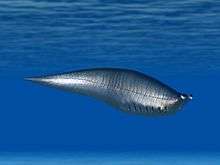Metaspriggina
| Metaspriggina Temporal range: Burgess Shale | |
|---|---|
 | |
| An artist's concept of Metaspriggina based on Conway Morris, Caron.[1] | |
| Scientific classification | |
| Kingdom: | Animalia |
| Phylum: | Chordata |
| Family: | Metaspriggiidae |
| Genus: | Metaspriggina |
| Species: | M. walcotti |
| Binomial name | |
| Metaspriggina walcotti | |
Metaspriggina is a genus of chordate initially known from two specimens in the Middle Cambrian Burgess Shale[2] and 44 specimens found in 2012 at the Marble Canyon bed in Kootenay National Park.[1]

Whilst named after the Ediacaran organism Spriggina, later work has shown the two to be unrelated.[2] Metaspriggina is considered to represent a primitive chordate, possibly transitional between cephalochordates and the earliest vertebrates. It lacked fins and had a poorly developed cranium, but did possess two well-developed upward-facing eyes with nostrils behind them.
Metaspriggina also possessed a notochord, along with seven pairs of pharyngeal bars, possibly made of cartilage. The largest specimens are 10 centimetres (3.9 in) in length. Originally believed to be free-swimming but occasionally found on the sea floor,[3][4] the fossils from Marble Canyon showing the presence of eyes and their placement suggests it lived as a filter-feeder swimming above the sea floor.
The exceptional preservation at Marble Canyon also preserved muscle detail, showing that the animal moved with a side-to-side swimming motion.[1] In Metaspriggina the myomeral configuration has an additional ventral chevron, and a clear dorsal bend which defines a W-shaped arrangement that is directly comparable to fish.[1]
The discovery of pharyngeal bars (gill bars) makes Metaspriggina the oldest known animal to have this feature.[1] The first pair of pharyngeal bars later evolved to form the upper and lower jaws of vertebrates.
References
- 1 2 3 4 5 Conway Morris, Simon; Caron, Jean-Bernard (June 11, 2014). "A primitive fish from the Cambrian of North America". Nature. London: Nature Publishing Group. doi:10.1038/nature13414. ISSN 0028-0836. Retrieved 2014-06-13.
- 1 2 3 Conway Morris, Simon (March 2008). "A Redescription of a Rare Chordate, Metaspriggina walcotti Simonetta and Insom, from the Burgess Shale (Middle Cambrian), British Columbia, Canada". Journal of Paleontology. Boulder, CO: The Paleontological Society. 82 (2): 424–430. doi:10.1666/06-130.1. ISSN 0022-3360. Retrieved 2014-06-13.
- 1 2 "Metaspriggina walcotti". Burgess Shale Fossil Gallery. Virtual Museum of Canada. 2011.
- ↑ Smith, M. Paul; Sansom, Ivan J.; Cochrane, Karen D. (2001). "The Cambrian origin of vertebrates". In Ahlberg, Per Erik. Major Events in Early Vertebrate Evolution: Palaeontology, Phylogeny, Genetics and Development. London; New York: Taylor & Francis. pp. 67–84. ISBN 0-415-23370-4. LCCN 00062919. OCLC 51667292.
External links
- "Metaspriggina walcotti". Burgess Shale Fossil Gallery. Virtual Museum of Canada. 2011.
- "New fossil find pinpoints the origin of jaws in vertebrates". Research at Cambridge: News. Cambridge, England: University of Cambridge. June 11, 2014. Retrieved 2014-06-13.